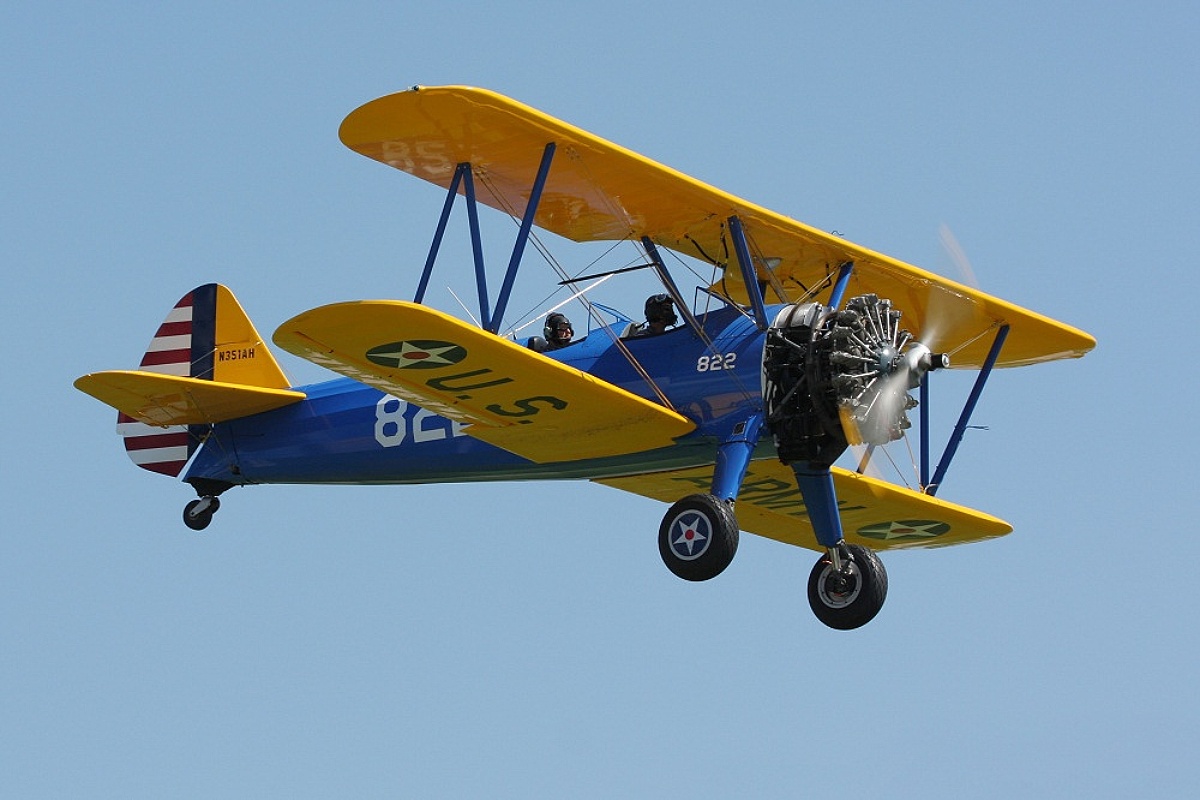Boeing Stearman PT-17 Kaydet also known as Model 75 is a rugged biplane with fixed landing gear, made usually with exposed radial engine. PT (Primary Trainer) hides the original purpose for which the machine served with the USAAF, US NAVY and RCAF throughout World War II. This plane can also be seen in several films, among them the most famous ones are the North-West North Point, Pilot’s Return, or the well-known comedy Two Mourners between Heaven and Hell.
The prototype, marked as Model 70, was completed by Stearman Aircraft in 1933. USAAC did not close this time, but 61 modified Model 73 models were supplied by the US Navy. For the US Navy, these machines received the NS-1. In September 1934, the United Aircraft and Transport Corporation was required by the Competition Act to separate its airlines from the aircraft manufacturers. At that time, Boeing became a separate company again, and Stearman Aircraft was its subsidiary. On the basis of many export successes, the A73L3 model ended in 1936 with the ultimate training model 75. In the same year a prototype registered for civilian use took off and was awarded the ATC 743 certificate.
Tests at the USAAC resulted in an order of 26 aircraft marked as PT-13 with a Lycoming R-680-5 star engine of 158 kW. Soon after, a contract for 92 PT-13A engines with a R-680-7 engine of 162 kW and 155 PT-13B with 206 kW R-680-11 was delivered. From version B, it was later 6 PT-13C aircraft designed for night flights. In 1939, the Boeing Airplane Company-Stearman Wichita Division was renamed to Boeing Wichita. The name Stearman continued to be unofficially used.
In the same year, the most popular model A75N1, which differed from the PT-13 by incorporating the seven-cylinder Continental R-670-4 or R-670-5 starter engine and the necessary changes in the installations. The USAAC ordered a total of 2,942 machines whose deliveries ended in January 1943. The first variant was the PT-17, which began PT-17A night treatment and later a special powder version PT-17B and C. For the US Navy was delivered to 250 aircraft N2S-1 and 455 N2S-4. In addition, the N2S-2 version with the Lycoming R-680-8 engine and approximately 2000 N2S-3 with the later R-670-4. RCAF has ordered 300 D75N1 models in winter gear that has been rewrote to Kaydet Mk.1. For administrative reasons, the USAAF PT-27 was also assigned to the exporting aircraft.
Later, there were 150 PT-18 and PT-18A (model A75J1) with a Jacobs R-755-7 engine of 165 kW. The latest Serial Type for the USAF was the E75 with a 165 kW Lycoming R-680-17 engine, derived from the PT-17C and designated PT-13D. The aircraft was delivered 855 pieces, the Navy then 873 as N2S-5. The production was completed in February 1945 and until then, 8,544 aircraft had been built on Boeing’s subsidiary site. After the war, thousands of surplus machines were sold to civilian owners, who are mostly used as powdering aircraft. These planes had a patch for pesticides or fertilizers that were mostly mounted in the front cockpit, and the original seven-cylinder engine was replaced with the larger Pratt & Whitney R-985 engine.
Wing walking and acrobatics
However, they have also found their use for recreational, sporting and aerobatic flying (including “walking on the wings”). One example is the Red Baron Stearman acrobatic group, which was set up in 1979 to promote Red Baron Pizza products. It was composed of five machines equipped with modified motors of about 335 kW. In particular, the engines were shown to be boned compared to the standard version. They served as a base for Minnesota Regional Airport (KMML), which was later established by an air museum named after this aircraft. Although it was officially the oldest aerial acrobatic group in 1993, it was performing until 2007.
Photogallery:
Version:
- Model 70
- Model 73 (NS-1)
- Model 73L3
- Model A73B1
- Model A73L3
- Stearman 75 (X75)
- X75L3 (prototyp PT-13)
- PT-13 (A-D)
- PT-17 (A-B)
- PT-18
- PT-18A (Model A75J1)
- PT-27 (Kaydet Mk.1)
- NS
- N2S
- N2S-1 (2-5)
- Stearman 76
- Stearman 90
- Stearman 91
- Stearman XPT-943
- American Airmotive NA-75
| Manufacturer | Boeing |
| Crew | student and instructor |
| Airplane type | Biplane |
| Engine | Continental R-670-5 |
| Engine power | 164 kW |
| Speed |
|
| Length | 7,39 m |
| Span | 9,80 m |
| Height | 2,79 m |
| Wing area | 27,63 m² |
| Weight | empty 878 kg
takeoff 1 232 kg |
| Available | 3 410 m |
| Flying range | 810 km |
source:
https://cs.wikipedia.org/wiki/Stearman_PT-17_Kaydet
http://en.wikipedia.org/wiki/Boeing-Stearman_Model_75










